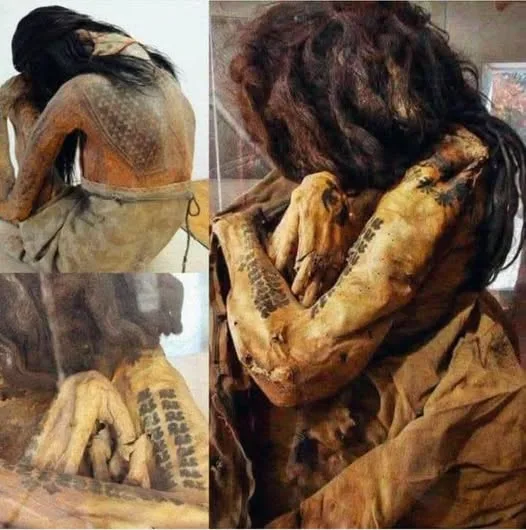The Tattooed Mummy of the Andes: A Glimpse into Ancient Art and Ritual
In a groundbreaking discovery high in the Peruvian Andes, archaeologists have unearthed a 1,700-year-old mummy adorned with intricate tattoos, likely from the Nazca or Paracas cultures. This extraordinary find, preserved by the region’s dry climate, offers a rare window into the artistry, spirituality, and burial practices of ancient Andean civilizations, revealing the profound role of body art in their society.
A Canvas of Ancient Art
The mummy’s tattoos are a stunning display of pre-Columbian craftsmanship, featuring geometric patterns, animals, and sacred symbols etched into the skin. These designs, likely created using bone or cactus-spine needles and natural pigments, suggest deep cultural significance. For the Nazca and Paracas peoples, who thrived between 200 BCE and 700 CE, tattoos may have denoted social status, tribal identity, or spiritual connections to deities and the natural world. Animals, such as birds or felines, could symbolize power or divine protection, while geometric motifs might reflect cosmological beliefs.
Insights into Andean Culture
The discovery sheds light on the role of body art in ancient Andean societies. Unlike temporary adornments, tattoos were permanent, suggesting a lifelong commitment to the identities or beliefs they represented. The presence of such detailed designs on a mummy indicates that body art was not only a living practice but also carried significance into the afterlife, possibly serving as a guide or marker in the spiritual realm. This find underscores the sophistication of Nazca and Paracas artistry, seen also in their vibrant textiles and intricate pottery.
Mummification and Preservation
The mummy’s remarkable preservation highlights the advanced mummification techniques of the Andean peoples. Likely naturally preserved by the arid Andean environment, the body retains not only its tattoos but also details of skin and tissue. The Nazca and Paracas cultures practiced both natural and intentional mummification, often wrapping bodies in layers of textiles and placing them in desert tombs. This mummy’s condition provides archaeologists with valuable data on these techniques, revealing how the Andes’ unique climate and cultural practices converged to preserve such delicate features.

A Window to the Past
The tattooed mummy is more than an archaeological artifact; it is a vivid testament to the intertwined worlds of art, identity, and spirituality in ancient Andean civilizations. Each tattoo tells a story—of status, belief, or connection to the cosmos—while the mummy itself reflects the care taken to honor the dead. This discovery enriches our understanding of the Nazca and Paracas cultures, whose legacies endure in their innovative art and complex worldviews.
A Lasting Legacy
Housed in a Peruvian research facility, the mummy continues to be studied, offering new insights into pre-Columbian life. Its tattoos, a rare surviving example of ancient body art, bridge the gap between the living and the dead, the earthly and the divine. As archaeologists unravel the meanings behind its designs, this find stands as a breathtaking reminder of the creativity and resilience of the Andean peoples, whose cultural heritage continues to captivate and inspire.


